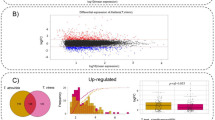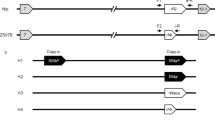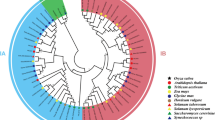Abstract
New gene origination is a major source of genomic innovations that confer phenotypic changes and biological diversity. Generation of new mitochondrial genes in plants may cause cytoplasmic male sterility (CMS), which can promote outcrossing and increase fitness. However, how mitochondrial genes originate and evolve in structure and function remains unclear. The rice Wild Abortive type of CMS is conferred by the mitochondrial gene WA352c (previously named WA352) and has been widely exploited in hybrid rice breeding. Here, we reconstruct the evolutionary trajectory of WA352c by the identification and analyses of 11 mitochondrial genomic recombinant structures related to WA352c in wild and cultivated rice. We deduce that these structures arose through multiple rearrangements among conserved mitochondrial sequences in the mitochondrial genome of the wild rice Oryza rufipogon, coupled with substoichiometric shifting and sequence variation. We identify two expressed but nonfunctional protogenes among these structures, and show that they could evolve into functional CMS genes via sequence variations that could relieve the self-inhibitory potential of the proteins. These sequence changes would endow the proteins the ability to interact with the nucleus-encoded mitochondrial protein COX11, resulting in premature programmed cell death in the anther tapetum and male sterility. Furthermore, we show that the sequences that encode the COX11-interaction domains in these WA352c-related genes have experienced purifying selection during evolution. We propose a model for the formation and evolution of new CMS genes via a “multi-recombination/protogene formation/functionalization” mechanism involving gradual variations in the structure, sequence, copy number, and function.
Similar content being viewed by others
Log in or create a free account to read this content
Gain free access to this article, as well as selected content from this journal and more on nature.com
or
References
Dyall SD, Brown MT, Johnson PJ . Ancient invasions: from endosymbionts to organelles. Science 2004; 304:253–257.
Lynch M, Koskella B, Schaack S . Mutation pressure and the evolution of organelle genomic architecture. Science 2006; 311:1727–1730.
Woloszynska M . Heteroplasmy and stoichiometric complexity of plant mitochondrial genomes-though this be madness, yet there's method in't. J Exp Bot 2010; 61:657–671.
Arrieta-Montiel MP, Mackenzie SA . Plant mitochondrial genomes and recombination. Plant Mitochon 2011; 1:65–82.
Chen L, Liu YG . Male sterility and fertility restoration in crops. Annu Rev Plant Biol 2014; 65:579–606.
Laser KD, Lersten NR . Anatomy and cytology of microsporogenesis in cytoplasmic male angiosperms. Bot Rev 1972; 38:425–454.
Huang X, Kurata N, Wei X, et al. A map of rice genome variation reveals the origin of cultivated rice. Nature 2012; 490:497–501.
Lin S, Yuan L . Hybrid Rice Breeding in China. Innovative Approaches to Rice Breeding 1980; Los Banos, Philippines, 35–51.
Cheng SH, Zhuang JY, Fan YY, Du JH, Cao LY . Progress in research and development on hybrid rice: a super-domesticate in China. Ann Bot 2007; 100:959–966.
Luo D, Xu H, Liu Z, et al. A detrimental mitochondrial-nuclear interaction causes cytoplasmic male sterility in rice. Nat Genet 2013; 45:573–577.
Tang H, Luo D, Zhou D, et al. The rice restorer Rf4 for wild–abortive cytoplasmic male sterility encodes a mitochondrial-ocalized PPR protein that functions in reduction of WA352 transcripts. Mol Plant 2014; 7:1497–1500.
Khush GS . Origin, dispersal, cultivation and variation of rice. Plant Mol Biol 1997; 35:25–34.
Liu YG, Chen Y . High-efficiency thermal asymmetric interlaced PCR for amplification of unknown flanking sequences. Biotechniques 2007; 43:649–656.
Okazaki M, Kazama T, Murata H, Motomura K, Toriyam K . Whole mitochondrial genome sequencing and transcriptional analysis to uncover an RT102-type cytoplasmic male sterility-associated candidate gene derived from Oryza rufipogon. Plant Cell Physiol 2013; 54:1560–1568.
Igarashi K, Kazama T, Motomura K, Toriyama K . Whole genomic sequencing of RT98 mitochondria derived from Oryza rufipogon and northern blot analysis to uncover a cytoplasmic male sterility-associated gene. Plant Cell Physiol 2013; 54:237–243.
Fujii S, Kazama T, Yamada M, Toriyama K . Discovery of global genomic re-organization based on comparison of two newly sequenced rice mitochondrial genomes with cytoplasmic male sterility-related genes. BMC Genomics 2010; 11:209.
Kazama T, Itabashi E, Fujii S, Nakamura T, Toriyama K . Mitochondrial ORF79 levels determine pollen abortion in cytoplasmic male sterile rice. Plant J 2016; 85:707–716.
Zou XH, Zhang FM, Zhang JG, et al. Analysis of 142 genes resolves the rapid diversification of the rice genus. Genome Biol 2008; 9:R49.
Zhu Q, Ge S . Phylogenetic relationships among A-genome species of the genus Oryza revealed by intron sequences of four nuclear genes. New Phytol 2005; 167:249–265.
Wang Z, Zou Y, Li X, et al. Cytoplasmic male sterility of rice with boro II cytoplasm is caused by a cytotoxic peptide and is restored by two related PPR motif genes via distinct modes of mRNA silencing. Plant Cell 2006; 18:676–687.
Notsu Y, Masood S, Nishikawa T, et al. The complete sequence of the rice (Oryza sativa L.) mitochondrial genome: frequent DNA sequence acquisition and loss during the evolution of flowering plants. Mol Genet Genomics 2002; 268:434–445.
Zhang QY, Liu YG . Rice mitochondrial genes are transcribed by multiple promoters that are highly diverged. J Integr Plant Biol 2006; 48:1473–1477.
Paull TT, Gellert M . A mechanistic basis for Mre11-directed DNA joining at microhomologies. Proc Natl Acad Sci USA 2000; 97:6409–6414.
Takata M, Sasaki MS, Sonoda E, et al. Homologous recombination and non-homologous end-joining pathways of DNA double-strand break repair have overlapping roles in the maintenance of chromosomal integrity in vertebrate cells. EMBO J 1998; 17:5497–5508.
Schubert I, Vu GTH . Genome stability and evolution: attempting a holistic view. Trends Plant Sci 2016; 21:749–757.
Tian X, Zheng J, Hu S, Yu J . The rice mitochondrial genomes and their variations. Plant Physiol 2006; 140:401–410
Bentolila S, Stefanov S . A reevaluation of rice mitochondrial evolution based on the complete sequence of male-fertile and male-sterile mitochondrial genomes. Plant Physiol 2012; 158:996–1017.
Zhang T, Hu S, Zhang G, et al. The organelle genomes of Hassawi rice (Oryza sativa L.) and its hybrid in Saudi Arabia: genome variation, rearrangement, and origins. PLoS One 2012; 7:e42041.
Kubo T, Mikami T . Organization and variation of angiosperm mitochondrial genome. Physiol Plant 2007; 129:6–13.
Yang Z . Likelihood ratio tests for detecting positive selection and application to primate lysozyme evolution. Mol Biol Evol 1998; 15:568–573.
Yang Z . PAML 4: phylogenetic analysis by maximum likelihood. Mol Biol Evol 2007; 24:1586–1591.
Long M, VanKuren NW, Chen S, Vibranovski MD . New gene evolution: little did we know. Annu Rev Genet 2013; 47:307–333.
Shedge V, Arrieta-Montiel M, Christensen AC, Mackenzie SA . Plant mitochondrial recombination surveillance requires unusual RecA and MutS homologs. Plant Cell 2007; 19:1251–1264.
Arrieta-Montiel MP, Shedge V, Davila J, Christensen AC, Mackenzie SA . Diversity of the Arabidopsis mitochondrial genome occurs via nuclear-controlled recombination activity. Genetics 2009; 183:1261–1268.
Lee C, Zeng J, Drew BG, et al. The mitochondrial-derived peptide MOTS-c promotes metabolic homeostasis and reduces obesity and insulin resistance. Cell Metab 2015; 21:443–454.
Cobb LJ, Lee C, Xiao J, et al. Naturally occurring mitochondrial-derived peptides are age-dependent regulators of apoptosis, insulin sensitivity, and inflammatory markers. Aging 2016; 8:796–809.
Carvunis AR, Rolland T, Wapinski I, et al. Proto-genes and de novo gene birth. Nature 2012; 487:370–374.
Wang W, Zhang J, Alvarez C, Llopart A, Long M . The origin of the jingwei gene and the complex modular structure of its parental gene, Yellow Emperor, in Drosophila melanogaster. Mol Biol Evol 2000; 17:1294–1301.
Zhang J, Dean AM, Brunet F, Long M . Evolving protein functional diversity in new genes of Drosophila. Proc Natl Acad Sci USA 2004; 101:16246–16250.
Siepel A . Darwinian alchemy: human genes from noncoding DNA. Genome Res 2009; 19:1693–1695.
Li D, Dong Y, Jiang Y, Jiang H, Cai J, Wang W . A de novo originated gene depresses budding yeast mating pathway and is repressed by the protein encoded by its antisense strand. Cell Res 2010; 20:408–420.
Ding Y, Zhou Q, Wang W . Origins of new genes and evolution of their novel functions. Annu Rev Ecol Evol Syst 2012; 43:345–363.
Neme R, Tautz D . Evolution: dynamics of de novo gene emergence. Curr Biol 2014; 24:R238–R240.
McLysaght A, Guerzoni D . New genes from non-coding sequence: the role of de novo protein-coding genes in eukaryotic evolutionary innovation. Phil Trans R Soc B 2015; 370:20140332.
Ross BD, Rosin L, Thomae AW, et al. Stepwise evolution of essential centromere function in a Drosophila neogene. Science 2013; 340:1211–1214.
Reznick DN, Ricklefs RE . Darwin's bridge between microevolution and macroevolution. Nature 2009; 457:837–842.
Caruso CM, Case AL, Bailey MF . The evolutionary ecology of cytonuclear interactions in angiosperms. Trends Plant Sci 2012; 17:638–643.
Greiner S, Bock R . Tuning a menage a trois: co-evolution and co-adaptation of nuclear and organellar genomes in plants. Bioessays 2013; 35:354–365.
Shedge V, Davila J, Arrieta-Montiel MP, Mohammed S, Mackenzie SA . Extensive rearrangement of the Arabidopsis mitochondrial genome elicits cellular conditions for thermotolerance. Plant Physiol 2010; 152:1960–1970.
Xu YZ, Arrieta-Montiel MP, Virdi KS, et al. MutS HOMOLOG1 is a nucleoid protein that alters mitochondrial and plastid properties and plant response to high light. Plant Cell 2011; 23:3428–3441.
Virdi KS, Laurie JD, Xu YZ, et al. Arabidopsis MSH1 mutation alters the epigenome and produces heritable changes in plant growth. Nat Commun 2015; 6:6386.
Hiei Y, Ohta S, Komari T, Kumashiro T . Efficient transformation of rice (Oryza sativa L.) mediated by Agrobacterium and sequence analysis of the boundaries of the T-DNA. Plant J 1994; 6:271–282.
Clough SJ, Bent AF . Floral dip: a simplified method for Agrobacterium-mediated transformation of Arabidopsis thaliana. Plant J 1998; 16:735–743.
Fan LM, Wang YF, Wang H, Wu WH . In vitro Arabidopsis pollen germination and characterization of the inward potassium currents in Arabidopsis pollen grain protoplasts. J Exp Bot 2001; 52:1603–1614.
Chen L, Wang F, Wang X, Liu Y-G . Robust one-tube Ω-PCR strategy accelerates precise sequence modification of plasmids for functional genomics. Plant Cell Physiol 2013; 54:634–642.
Tamura K, Dudley J, Nei M, Kumar S . MEGA4: molecular evolutionary genetics analysis (MEGA) software version 4.0. Mol Biol Evol 2007; 24:1596–1599.
Acknowledgements
We thank X Liu for providing some of the wild and cultivated rice materials preserved in South China Agricultural University, and H Yu for assistance in the sequence analysis with the CODEML program. We also thank H Wang, D Charlesworth, W Wang, C-I Wu, X-L He, H Ma, Q Zhang, Y Ouyang, and K Tsunewaki for comments on this study and/or the manuscript. This work was supported by grants from the National Nature Science Foundation of China (31230052), the Ministry of Science and Technology of China (2013CBA01401 and 2013CB126904), the Nature Science Foundation of Guangdong Province, China (2014A030310399), and the Postdoctoral Science Foundation of China (2015M570717).
Author information
Authors and Affiliations
Corresponding authors
Additional information
( Supplementary information is linked to the online version of the paper on the Cell Research website.)
Supplementary information
Supplementary information, Table S2
Specific primers used for hiTAIL-PCR (Figure 1). (PDF 29 kb)
Supplementary information, Table S3
Primers used for preparation of the plant transformation vector constructs (Figure 2A). (PDF 25 kb)
Supplementary information, Table S5
Primers used for quantitative PCR (Figure 5B). (PDF 25 kb)
Supplementary information, Table S6
Primers used for qRT-PCR (Figure 3). (PDF 25 kb)
Supplementary information, Table S7
Primers used for construction of yeast two-hybrid vectors (Figure 6A, C, D and Figure S7). (PDF 29 kb)
Supplementary information, Figure S1
Male sterility and fertility and the co-segregation with the transgenes in the rice and Arabidopsis transgenic plants. (PDF 205 kb)
Supplementary information, Figure S2
Fertility phenotypes of Arabidopsis T1 plants with MTS-WA314. (PDF 295 kb)
Supplementary information, Figure S3
Male phenotype of the backcrossed rice lines. (PDF 197 kb)
Supplementary information, Figure S4
Detection of therpl5/cox1/orf284 configuration in Oryza species. (PDF 117 kb)
Supplementary information, Figure S5
Comparison among the conserved sequences of the recombinant structures and those from other plant species as references. (PDF 200 kb)
Supplementary information, Figure S6
The repeat sites for recombination events among the donor (source) sequences to generate the new structures. (PDF 417 kb)
Supplementary information, Figure S7
Coexistence of S314a, S276 and S310 and their substoichiometric shifting. (PDF 111 kb)
Supplementary information, Figure S8
Alignment of the protein sequences of the CMS genes and CMS-related ORFs. (PDF 82 kb)
Supplementary information, Figure S9
Yeast two-hybrid assay of the COX11-interaction of the cs1-encoded polypeptides of the CMS genes and the related ORFs. (PDF 147 kb)
Rights and permissions
About this article
Cite this article
Tang, H., Zheng, X., Li, C. et al. Multi-step formation, evolution, and functionalization of new cytoplasmic male sterility genes in the plant mitochondrial genomes. Cell Res 27, 130–146 (2017). https://doi.org/10.1038/cr.2016.115
Received:
Revised:
Accepted:
Published:
Issue date:
DOI: https://doi.org/10.1038/cr.2016.115
Keywords
This article is cited by
-
Mitochondrial genome structural variants and candidate cytoplasmic male sterility-related gene in sugarcane
BMC Genomics (2025)
-
Past and future of cytoplasmic male sterility and heterosis breeding in crop plants
Plant Cell Reports (2025)
-
The first two whole mitochondrial genomes for the genus Dactylis species: assembly and comparative genomics analysis
BMC Genomics (2024)
-
Insights into cellular crosstalk regulating cytoplasmic male sterility and fertility restoration
Molecular Biology Reports (2024)
-
Investigation of B-atp6-orfH79 distributing in Chinese populations of Oryza rufipogon and analysis of its chimeric structure
BMC Plant Biology (2023)



